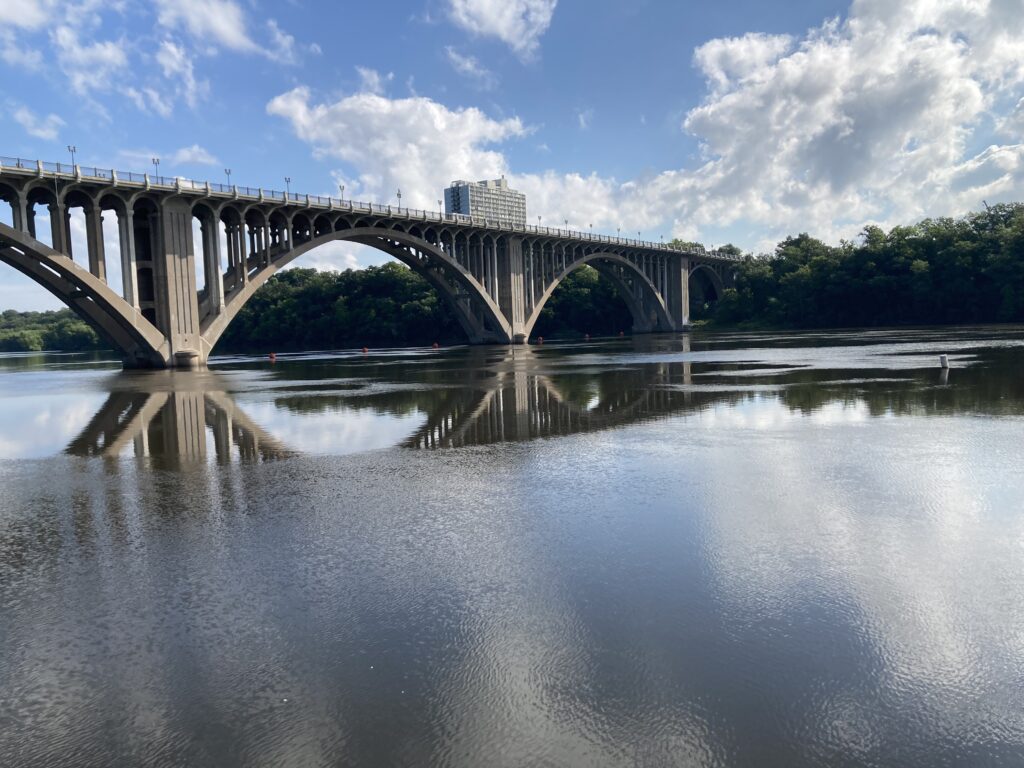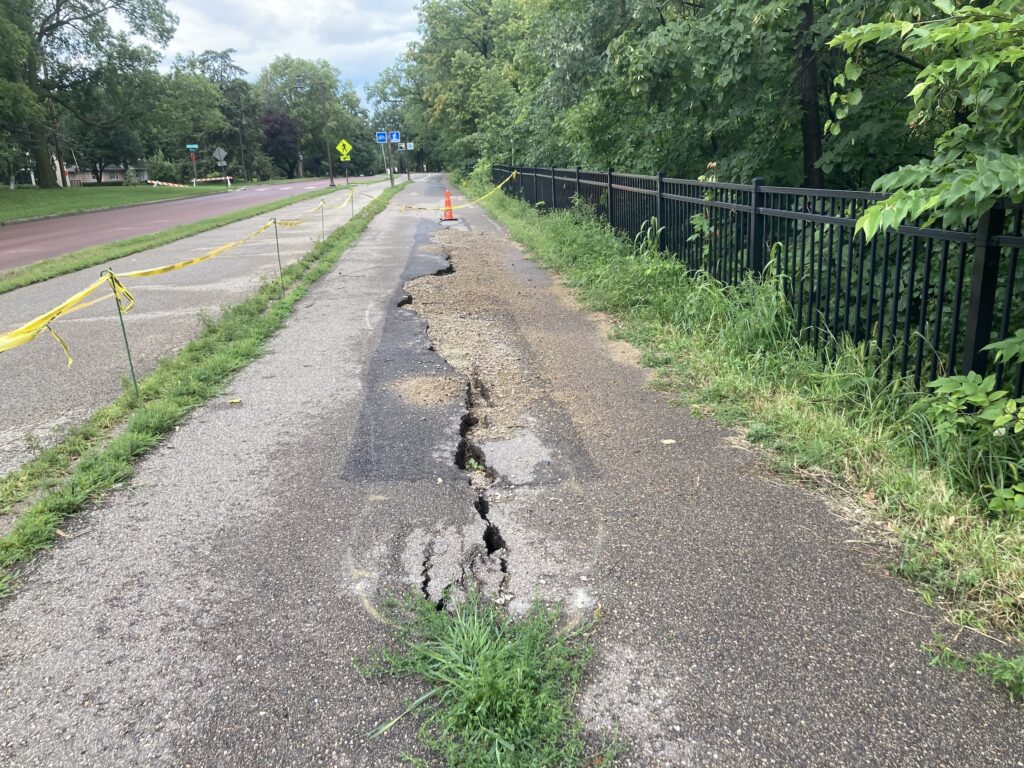bike: 8.6 miles
lake nokomis and back
64/71 degrees
Hooray for feeling comfortable on a bike! Able to see enough to not feel scared.
…sitting on the back deck to write this, a wave of ear piercing cicada buzz just passed by. Wow! What’s the decibel level of that?
Rode into the wind for a lot of the ride — and not just the wind I was making with my moving body. Wondered if it would be choppy at the lake. (it was). At one point, when the wind seemed particularly strong, I could feel how un-aerodynamic I was — an upright form fighting against air. I tried to get more aerodynamic, leaning low and over my hips, my bike as parallel to the ground as I could get it. Thought about ironman triathletes who can bike like in an even more parallel position for almost 5 hours. Wow, how many hours of training and lifting and working with a coach must you need to keep that form for so long?
The bike ride back was wonderful. What a beautiful late summer day! Sunny, warm in a way that’s welcome because it was cooler in the morning.
swim: 2 loops
56 minutes
lake nokomis main beach
66 degrees
I did it! 1440 minutes, 24 hours, one day swimming in August! Hooray for ambitious goals that push you to do a little more than you would have otherwise. Swimming a total of 24 hours (over 21 swims) was a commitment for sure, but it wasn’t an unreasonable commitment. And the biggest challenge was not getting my body to swim that many minutes — and miles, over 40 — but having clean water and an open lake. Lake Nokomis was closed for 2 weeks in August due to elevated e-coli and algae blooms.
24 hours was a good goal. Enough to challenge me and enable me to get deeper into my swimming and writing about swimming, but not too deep to sink me, to overwhelm and injure me. That’s another definition of Mary Oliver’s deepening and quieting of the spirit: deepening my commitment, steadily chipping away at the time (a quiet = still = steady approach).
The water was empty of other humans. I don’t remember seeing/hearing any ducks or geese or seagulls either. Lots of milfoil, both tethered and floating in segments on the surface. Too many milfoil vines near the white buoys. They seem to be increasing every time I swim. Boo! I went much farther out to avoid them, and when I veered closer, I could feel them wrapping around my wrists and ankles. Join us, I briefly imagined them saying. No thanks!
Yesterday while looking up recent drownings in Lake Nokomis — the ones I remember are the South High football player in 2013 and the 11 year old girl in 2023 — I discovered that someone else drowned last week. A woman who (presumably) took her own life. Rescuers were searching for more than 24 hours, looking for the body. They found it. As I swam out to the white buoys, I thought about this woman and the others that had drowned, wondered how terrified I would be to encounter their dead bodies bobbing in the water. Another meaning of deepening/quieting of the spirit.
The water shimmered in the sun, sometimes like silver, sometimes glass. There were little waves, big enough to make a noise, but not big enough for white caps. Before I got used to the rocking movement, I was slightly dizzy. I liked the chop. I was able to got faster heading north with the wind, and more powerfully heading south against it.
The sky was a deep blue with a few clouds. They were fluffy like cotton balls, some of them big, like a whole ball, some of them wispy and small, like one chunk of the ball. Noticed a plane, parallel to the water.
The water was thick with particles, impossible to see too far in front of me — only my hand and the trailing bubbles.
Heading north, following the path of an open swim loop, I looked up and imagined that the orange buoy was far off in the distance. Oh, to have it appear to be able to swim out and beyond it!
When I finished the swim, I sat on the sand, feeling the sun on my back, looking out at the water and reflecting on the season. What a summer! I hope to come back to the lake more times this week and until they remove the buoys, but whatever happens, I met my goal and have no regrets about how much I swam this summer. Good job, Sara!
today’s inspiration
One of the poems-of-the-day offers inspiration for my Swimming One Day project:
Task/ Ari Banias
There’s a poem I tried to write about
bathing you the last day you were alive.
On one of our drives home:
I want to die without shame.
You didn’t elaborate.
I described standing across from a stranger
paid to do this work, her presence
anchoring me in the task
with you between us.
From this distance I can use the word task.
Your pain the astrologer said A gift
for others
A mixing bowl
filled with warm water
we dipped washcloths into before
wringing them out
rested between your legs.
The phrase utilitarian tenderness served
some containing purpose
I needed at the time.
A great effort
to come up to the surface of yourself
to say what you said to us.
A student writes two lines
about an aging parent
they think are boring and may cut.
That poem did not belong
to language, and surpassed touch
Dough rising somewhere
under a red and white
dishtowel in that bowl
about this poem
“The task is attempting to write the poem again the task is bathing the dying the task is work done for wages the task is recognizing the encounter that refuses containment that insists on experience outside narrative time the task is to not entomb memory in language to not reduce grief to a quotable thing the task is to feel the edge of a void and keep going inside the feeling the task summons in you the task continues despite”
inspirations
- create a set of poems — one of them is the main poem, another about it, explaining it in some way, sideways or front ways or back ways, and maybe a third one that condenses it (like Hardly Creatures and the original poem, replica, souvenir)
- a pair of poems, the second, the reflection of the first, as if on the surface of water, and darker, like A Oswald’s line about water letting you see twice but more darkly
- take an idea — in the poem it is “task” — and play around with a wide range of meaning. I’m thinking: “day” or “quiet/still”
run: 2.45 miles
around lake nokomis
76 degrees
Went back to the lake in the evening with Scott. He started running north, I started south around the lake. I haven’t run here at all this summer. Stopped at the little beach briefly to check out the algae. Since my swim this morning, the test results have come in and there is an blue-green algae advisory at both beaches. They tested it on Monday when it was the worst. It’s better today.
Over halfway around, I passed a young boy walking by himself. After I passed him, I heard somebody running like they were trying to catch me. I think it was him. The footsteps lasted for 30 seconds? a minute? then stopped. I kept running until I reached the overlook on the cedar bridge then briefly stopped to take in the view. I noticed waves and the silhouettes of 2 kayaks in the distance, silvery water.
10 Lake Things
- a guy calling out, no! drop it! drop it! no! no! — I’m assuming they were talking to their dog, but I didn’t see
- a kid’s loud foot strikes
- a group of people crossing the path, heading for the dock
- the soft sand of the dirt trail next to the path
- 2 kids climbing the leaning tree that I used to run by and think it looked like a woman arching her back
- an opening in the vegetation, an empty bench, a person closer to shore
- 2 women’s voices on the water near shore — were they in a kayak or a canoe?
- the bridge has lane markings for a bike path — that’s new
- the smell of cigarette smoke near the booth where they test for zebra mussels
- a woman and a man blocking part of the path — the guy practicing a stretch as the woman gave him pointers — his coach?

